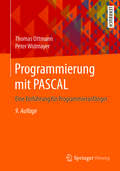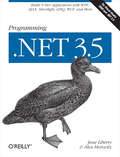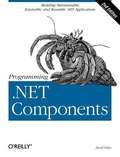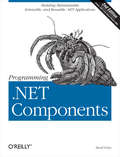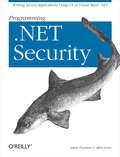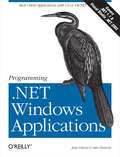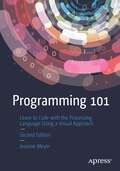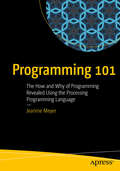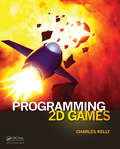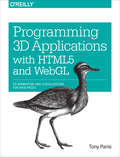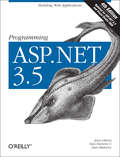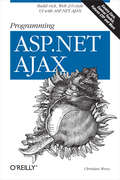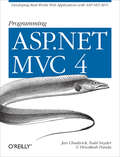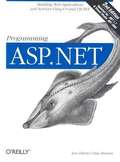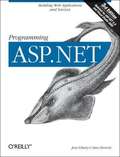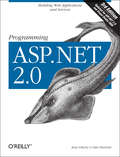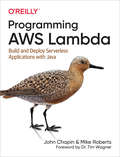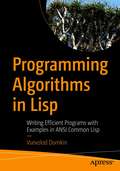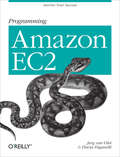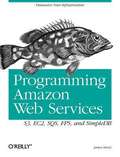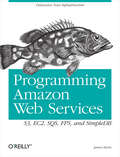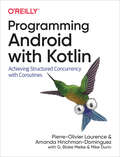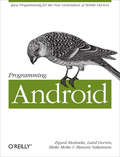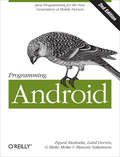- Table View
- List View
Programmierung mit PASCAL: Eine Einführung für Programmieranfänger
by Thomas Ottmann Peter WidmayerDie Darstellung gibt eine Einführung in Pascal, die auch für Anfänger ohne Informatikkenntnisse verständlich ist. Ausgegangen wird von der Notwendigkeit, dass es nicht ausreicht, lediglich den mit dem Programmieren verbundenen Formalisierungsprozess zu erklären. Schwerpunkt des Buches ist vielmehr eine genaue Formulierung und weitgehend programmiersprachenunabhängige algorithmische Lösung von Problemen. Auf diesem Wege werden die Grundsätze des Schreibens guter Pascal-Programme illustriert.
Programming .NET 3.5: Build N-Tier Applications with WPF, AJAX, Silverlight, LINQ, WCF, and More
by Jesse Liberty Alex Horovitz.NET 3.5 will help you create better Windows applications, build Web Services that are more powerful, implement new Workflow projects and dramatically enhance the user's experience. But it does so with what appears to be a collection of disparate technologies. In Programming .NET 3.5, bestselling author Jesse Liberty and industry expert Alex Horovitz uncover the common threads that unite the .NET 3.5 technologies, so you can benefit from the best practices and architectural patterns baked into this newest generation of Microsoft frameworks. While single-topic .NET 3.5 books delve into Windows Presentation Foundation and the other frameworks in greater detail, Programming .NET 3.5 offers a "Grand Tour" of the release that describes how the four principal technologies can be used together, with Ajax, to build modern n-tier and service-oriented applications. Developers have struggled to implement these patterns with previous versions of the .NET Framework, but this hands-on guide uses real-world examples and fully annotated source code to demonstrate how .NET 3.5 can make it easy. The concepts and technologies that this book covers include: XAML -- Microsoft's new XML-based markup language for UI, used with WPF Windows Presentation Foundation (WPF) -- a new presentation framework and graphics subsystem for Windows that puts Vista-like effect in your grasp Ajax Windows Communication Foundation (WCF) - a new standards-based framework that enables applications to communicate across a network using a variety of protocols Workflow Foundation (WF) -- framework for defining, executing, and managing workflows CardSpace -- framework for managing the identities of your users You'll learn how to use each of the four frameworks alone and in concert to build a series of meaningful example applications. Examples are written in C#, and all of the source code will be available for download at both the O'Reilly and the authors' site, which offers access to a free support forum. Between them, authors Jesse Liberty and Alex Horovitz have nearly forty years of experience in delivering commercial applications for companies such as Citibank, Apple, AT&T, NeXt, PBS, Ziff Davis, and dozens of smaller organizations. Their combined experience is valuable for telling the story of .NET 3.5 and how it will shorten the development life cycle for applications developers, and enhance your productivity.
Programming .NET Components, 2nd Edition
by Juval LowyBrilliantly compiled by author Juval Lowy, Programming .NET Components , Second Edition is the consummate introduction to the Microsoft .NET Framework--the technology of choice for building components on Windows platforms. From its many lessons, tips, and guidelines, readers will learn how to use the .NET Framework to program reusable, maintainable, and robust components. Following in the footsteps of its best-selling predecessor, Programming .NET Components , Second Edition has been updated to cover .NET 2.0. It remains one of the few practical books available on this topic. This invaluable resource is targeted at anyone who develops complex or enterprise-level applications with the .NET platform--an ever-widening market. In fact, nearly two million Microsoft developers worldwide now work on such systems. Programming .NET Components , Second Edition begins with a look at the fundamentals of component-oriented programming and then progresses from there. It takes the time to carefully examine how components can simplify and add flexibility to complex applications by allowing users to extend their capabilities. Next, the book introduces a variety of .NET essentials, as well as .NET development techniques. Within this discussion on component development, a separate chapter is devoted to each critical development feature, including asynchronous calls, serialization, remoting, security, and more. All the while, hazardous programming pitfalls are pointed out, saving the reader from experiencing them the hard way. A .NET expert and noted authority on component-oriented programming, Lowy uses his unique access to Microsoft technical teams to the best possible advantage, conveying detailed, insider information in easy-to-grasp, activity-filled language. This hands-on approach is designed to allow individuals to learn by doing rather than just reading. Indeed, after digesting Programming .NET Components , Second Edition, readers should be able to start developing .NET components immediately. Programming .NET Components , Second Edition is the consummate introduction to the Microsoft .NET Framework--the technology of choice for building components on Windows platforms. From its many lessons, tips, and guidelines, readers will learn how to use the .NET Framework to program reusable, maintainable, and robust components. Following in the footsteps of its best-selling predecessor, Programming .NET Components , Second Edition has been updated to cover .NET 2.0. This invaluable resource is targeted at anyone who develops complex or enterprise-level applications with the .NET platform--an ever-widening market.
Programming .NET Components: Design and Build .NET Applications Using Component-Oriented Programming
by Juval LowyBrilliantly compiled by author Juval Lowy, Programming .NET Components, Second Edition is the consummate introduction to the Microsoft .NET Framework--the technology of choice for building components on Windows platforms. From its many lessons, tips, and guidelines, readers will learn how to use the .NET Framework to program reusable, maintainable, and robust components.Following in the footsteps of its best-selling predecessor, Programming .NET Components, Second Edition has been updated to cover .NET 2.0. It remains one of the few practical books available on this topic. This invaluable resource is targeted at anyone who develops complex or enterprise-level applications with the .NET platform--an ever-widening market. In fact, nearly two million Microsoft developers worldwide now work on such systems.Programming .NET Components, Second Edition begins with a look at the fundamentals of component-oriented programming and then progresses from there. It takes the time to carefully examine how components can simplify and add flexibility to complex applications by allowing users to extend their capabilities. Next, the book introduces a variety of .NET essentials, as well as .NET development techniques. Within this discussion on component development, a separate chapter is devoted to each critical development feature, including asynchronous calls, serialization, remoting, security, and more. All the while, hazardous programming pitfalls are pointed out, saving the reader from experiencing them the hard way.A .NET expert and noted authority on component-oriented programming, Lowy uses his unique access to Microsoft technical teams to the best possible advantage, conveying detailed, insider information in easy-to-grasp, activity-filled language. This hands-on approach is designed to allow individuals to learn by doing rather than just reading. Indeed, after digesting Programming .NET Components, Second Edition, readers should be able to start developing .NET components immediately.Programming .NET Components, Second Edition is the consummate introduction to the Microsoft .NET Framework--the technology of choice for building components on Windows platforms. From its many lessons, tips, and guidelines, readers will learn how to use the .NET Framework to program reusable, maintainable, and robust components.Following in the footsteps of its best-selling predecessor, Programming .NET Components, Second Edition has been updated to cover .NET 2.0. This invaluable resource is targeted at anyone who develops complex or enterprise-level applications with the .NET platform--an ever-widening market.
Programming .NET Security: Writing Secure Applications Using C# or Visual Basic .NET
by Adam Freeman Allen JonesWith the spread of web-enabled desktop clients and web-server based applications, developers can no longer afford to treat security as an afterthought. It's one topic, in fact, that .NET forces you to address, since Microsoft has placed security-related features at the core of the .NET Framework. Yet, because a developer's carelessness or lack of experience can still allow a program to be used in an unintended way, Programming .NET Security shows you how the various tools will help you write secure applications.The book works as both a comprehensive tutorial and reference to security issues for .NET application development, and contains numerous practical examples in both the C# and VB.NET languages. With Programming .NET Security, you will learn to apply sound security principles to your application designs, and to understand the concepts of identity, authentication and authorization and how they apply to .NET security. This guide also teaches you to:use the .NET run-time security features and .NET security namespaces and types to implement best-practices in your applications, including evidence, permissions, code identity and security policy, and role based and Code Access Security (CAS) use the .NET cryptographic APIs , from hashing and common encryption algorithms to digital signatures and cryptographic keys, to protect your data.use COM+ component services in a secure mannerIf you program with ASP.NET will also learn how to apply security to your applications. And the book also shows you how to use the Windows Event Log Service to audit Windows security violations that may be a threat to your solution.Authors Adam Freeman and Allen Jones, early .NET adopters and long-time proponents of an "end-to-end" security model, based this book on their years of experience in applying security policies and developing products for NASDAQ, Sun Microsystems, Netscape, Microsoft, and others. With the .NET platform placing security at center stage, the better informed you are, the more secure your project will be.
Programming .NET Windows Applications
by Jesse Liberty Dan HurwitzWith this tutorial, you will explore all aspects of using .NET Windows Forms class libraries and the associated programming tools in Visual Studio .NET, enabling you to build applications for the Windows 9x, Windows 2000 and Windows XP desktop platforms. Step-by-step, you'll learn ways to design applications that either function alone on a PC, or work in combination with your web-based application server to take advantage of the richer interface and higher level of security.
Programming 101: Learn to Code with the Processing Language Using a Visual Approach
by Jeanine MeyerProgramming permeates almost all aspects of our lives. This includes being active on social media, shopping online, and participating in virtual courses. It also includes driving a car and using many devices. This book will teach you the basics of programming using the Processing programming language and provide practice with logical, algorithmic thinking. It can provide insight into what is involved in producing the technical infrastructure of our world. While reading this book, you can build programs based on your own ideas, using images you create or acquire and making connections to activities you enjoy. The chapters in the book will demonstrate the process of programming, starting with formulating an idea, planning, building on past projects, and refining the work, similar to writing an essay or composing a song. This approach will guide you to make use of logic and mathematics to produce beautiful effects. The text contains an Appendix with an introduction to p5.js, a way to produce JavaScript programs with Processing functionality for drawing, images, and interactions to publish on the Web. The term for program in Processing is sketch. The Processing language has been constructed by visual artists using the Java programming language as a base. However, the sketches featured in this book and typical in Processing are far more than static drawings; they incorporate interaction, animation, video, audio, and accessing files on the local computer and on the Web. Technical features are introduced and explained in the context of complete examples: games (Snake, Hangman, jigsaw, slingshot), making a collage of family images and video clips, preparing directions for folding an origami model, rotating objects in 3D, and others. Programming is a fun, creative, expressive pursuit. It does require attention to details and can be frustrating. Still, there is very little that compares to the satisfaction of building a program out of nothing and making it work (or taking an existing program and fixing a problem, or adding a feature and making it better). Programming 101 is your gateway to making this happen. What You'll Learn Gain basic programming skills Build fun and creative programs Use files for making a holiday card or a sequence of instructions Combine videos, images, and graphics in a Processing sketch Connections to other programming languages, most especially Java and JavaScript Who This Book Is For Anyone who has been thinking about trying programming, or has tried, but needs assistance. Anyone who wants to use their own creativity and artistic talents. Anyone who wants to know what is involved in the technology that is present in our lives. Anyone who wants to know what is involved in the technology that is present in our lives.
Programming 101: The How and Why of Programming Revealed Using the Processing Programming Language
by Jeanine MeyerUnderstand the importance of programming, even if you’ve never programmed before! This book will teach you the basics of programming using the Processing programming language. You will create your own Processing sketches, using personal images, themes, or hobbies that you enjoy. The chapters in the book will demonstrate the process of programming, starting with formulating an idea, planning, building on past projects, and refining the work, similar to writing an essay or composing a song. This approach will guide you to make use of logic and mathematics to produce beautiful effects.The term for program in Processing is sketch, though the sketches featured in this book are far more than static drawings; they incorporate interaction, animation, video, audio, and accessing files on the local computer and on the Web. Technical features are introduced and explained in the context of complete examples: games (Snake, Hangman, jigsaw, slingshot), making a collage of family images and video clips, preparing directions for folding an origami model, rotating objects in 3D, and others.Programming is a fun, creative, expressive pursuit. It requires attention to details and can be frustrating, but there is very little that compares to the satisfaction of building a program out of nothing and making it work (or taking an existing program and fixing a problem, or adding a feature and making it better). Programming 101 is your gateway to making this happen. What You Will Learn Gain basic programming skillsBuild fun and creative programsUse files for making a holiday cardCombine videos, images, and graphics in a Processing sketch Who This Book Is For Anyone who has been thinking about trying programming, or has tried, but needs more motivation; anyone who wants to learn about the Processing language.
Programming 2D Games
by Charles KellyA First Course in Game ProgrammingMost of today's commercial games are written in C++ and are created using a game engine. Addressing both of these key elements, Programming 2D Games provides a complete, up-to-date introduction to game programming. All of the code in the book was carefully crafted using C++. As game programming techniques are intro
Programming 3D Applications with HTML5 and WebGL: 3D Animation and Visualization for Web Pages
by Tony ParisiCreate high-performance, visually stunning 3D applications for the Web, using HTML5 and related technologies such as CSS3 and WebGL—the emerging web graphics standard. With this book, you’ll learn how to use the tools, frameworks, and libraries for building 3D models and animations, mind-blowing visual effects, and advanced user interaction in both desktop and mobile browsers.In two parts—Foundations and Application Development Techniques—author Tony Parisi provides a thorough grounding in theory and practice for designing everything from a simple 3D product viewer to immersive games and interactive training systems. Ideal for developers with Javascript and HTML experience.Explore HTML5 APIs and related technologies for creating 3D web graphics, including WebGL, Canvas, and CSSWork with the popular JavaScript 3D rendering and animation libraries Three.js and Tween.jsDelve into the 3D content creation pipeline, and the modeling and animation tools for creating killer 3D contentLook into several game engines and frameworks for building 3D applications, including the author’s Vizi frameworkCreate 3D environments with multiple objects and complex interaction, using examples and supporting codeExamine the issues involved in building WebGL-based 3D applications for mobile browsers
Programming ASP.NET 3.5, Fourth Edition
by Jesse Liberty Dan Hurwitz Dan MaharryWith Programming ASP.NET 3.5, you'll quickly learn to create state-of-the-art applications using Microsoft's popular web development technology and Visual Studio 2008. This updated bestseller provides comprehensive and easy-to-understand information to help you use several .NET 3.5 technologies for faster development and better web application performance-including ASP.NET AJAX for interactive user interfaces, LINQ for data access, and Windows Communication Foundation (WCF) for web services. Programming ASP.NET 3.5 includes examples and sample code that let you explore development with ASP.NET in more depth. With this book, you will: * Learn about AJAX and ASP.NET server controls included with Visual Studio 2008 * Discover how to use the DataSource and data-bound controls in ADO.NET * Use the new LINQ API and learn how to make use of it within ASP.NET pages * Create a uniform look and feel throughout your application with Master Pages * Use navigation controls to build site maps, menus, and breadcrumbs quickly and easily * Build and use various web services with WCF * Detect errors during development and handle them in your production code * Learn how to configure and deploy your website Written by Microsoft technology experts Jesse Liberty, Dan Hurwitz, and Dan Maharry, Programming ASP.NET 3.5 is the best book for learning how to build dynamic, interactive web applications using Microsoft's latest technologies.
Programming ASP.NET 3.5: Building Web Applications
by Jesse Liberty Dan Hurwitz Dan MaharryWith Programming ASP.NET 3.5, you'll quickly learn to create state-of-the-art applications using Microsoft's popular web development technology and Visual Studio 2008. This updated bestseller provides comprehensive and easy-to-understand information to help you use several .NET 3.5 technologies for faster development and better web application performance-including ASP.NET AJAX for interactive user interfaces, LINQ for data access, and Windows Communication Foundation (WCF) for web services.Programming ASP.NET 3.5 includes examples and sample code that let you explore development with ASP.NET in more depth. With this book, you will: Learn about AJAX and ASP.NET server controls included with Visual Studio 2008 Discover how to use the DataSource and data-bound controls in ADO.NET Use the new LINQ API and learn how to make use of it within ASP.NET pages Create a uniform look and feel throughout your application with Master Pages Use navigation controls to build site maps, menus, and breadcrumbs quickly and easily Build and use various web services with WCF Detect errors during development and handle them in your production code Learn how to configure and deploy your website Written by Microsoft technology experts Jesse Liberty, Dan Hurwitz, and Dan Maharry, Programming ASP.NET 3.5 is the best book for learning how to build dynamic, interactive web applications using Microsoft's latest technologies.
Programming ASP.NET AJAX
by Christian WenzDelivering rich, Web 2.0-style experiences has never been easier. This book gives you a complete hands-on introduction to Microsoft ASP.NET AJAX 1.0, the new framework that offers many of the same benefits for Ajax development that ASP.NET provides for server-side development. With Programming ASP.NET AJAX, you'll learn how to create professional, dynamic web pages with Ajax in no time. Loaded with code and examples that demonstrate key aspects of the framework, this book is ideal not only for ASP.NET developers who want to take their applications a step further with Ajax, but for any web developers interested in ASP.NET AJAX, no matter what technology they use currently. That includes JavaScript programmers who would like to avoid the headaches of writing cross-browser code.Programming ASP.NET AJAX offers you: A high-level overview of the ASP.NET AJAX framework Functional code that you can cut and paste for use in your own applications The essentials of JavaScript and Ajax to help you understand individual technologies used by the framework An organization that reflects the framework's packages, including Extensions, Control Toolkit, the Futures CTP, and the AJAX Library Sidebars throughout the book that identify and propose solutions to potential security breaches Ways to use the standards-based AJAX Library with other platforms, such as PHP A complete chapter on the UpdatePanel control for making individual parts of a web page independently updateable -- one of the framework's most important elements Released previously as Programming Atlas to cover the beta version of the Microsoft framework, this edition is fully up-to-date and expanded for the official 1.0 release of ASP.NET AJAX. Written by Christian Wenz -- Microsoft MVP for ASP/ASP.NET and AJAX Control Toolkit Contributor -- Programming ASP.NET AJAX contains many hard-to-find details, along with a few unofficial ways to accomplish things.
Programming ASP.NET MVC 4: Developing Real-World Web Applications with ASP.NET MVC
by Hrusikesh Panda Jess Chadwick Todd SnyderGet up and running with ASP.NET MVC 4, and learn how to build modern server-side web applications. This guide helps you understand how the framework performs, and shows you how to use various features to solve many real-world development scenarios you’re likely to face. In the process, you’ll learn how to work with HTML, JavaScript, the Entity Framework, and other web technologies.You’ll start by learning core concepts such as the Model-View-Controller architectural pattern, and then work your way toward advanced topics. The authors demonstrate ASP.NET MVC 4 best practices and techniques by building a sample online auction site ("EBuy") throughout the book.Learn the similarities between ASP.NET MVC 4 and Web FormsUse Entity Framework to create and maintain an application databaseCreate rich web applications, using jQuery for client-side developmentIncorporate AJAX techniques into your web applicationsLearn how to create and expose ASP.NET Web API servicesDeliver a rich and consistent experience for mobile devicesApply techniques for error handling, automated testing, and build automationUse various options to deploy your ASP.NET MVC 4 application
Programming ASP.NET, 2nd Edition
by Jesse Liberty Dan HurwitzIn Programming ASP.NET , Second Edition authors Jesse Liberty and Dan Hurwitz cover everything you need to know to be effective with ASP.NET. The book includes a comprehensive tutorial on Web Forms, which, in conjunction with Visual Studio .NET 2003, allow you to apply Rapid Application Development techniques (including drag-and-drop control placement) to web development. Programming ASP.NET includes extensive coverage of each type of server control, including Web server controls, HTML server controls, and custom controls. New material covers creating ASP.NET pages for mobile devices.
Programming ASP.NET, 3rd Edition
by Jesse Liberty Dan HurwitzO'Reilly has once again updated its bestselling tutorial on ASP.NET, the world's leading web development tool from Microsoft. In Programming ASP.NET , Third Edition, author Jesse Liberty gives you the lowdown on the technology's latest version, ASP.NET 2.0, as well as Visual Studio 2005. One of the most significant improvements to ASP.NET 2.0 is its intuitive nature. In fact, when compared to its predecessor, ASP.NET 2.0 reduces the amount of code you have to write by about 75%. Creating interactive web applications has never been easier-but that still doesn't mean it's hassle-free! The difficulty in ASP.NET 2.0 is that it's so complete and flexible that there are many pieces that must be woven together to build a robust, scalable, and efficient application. Fortunately, Programming ASP.NET , Third Edition is on the case, dispensing all the information you need to be effective with this dynamic tool. For starters, the book features a comprehensive tutorial on Web Forms, the user interface that gives web applications their look and feel. It then offers detailed explanations of all new controls, including Web server controls, HTML controls, and custom controls. Used properly, these controls are able to take care of nearly all the foundation work-security, data access, layout, etc.-that you would normally have to write yourself. Free of these burdensome tasks, you can instead focus on your specific application. Other new material found in this updated edition even shows you how to create ASP.NET 2.0 pages for mobile devices. With Programming ASP.NET , Third Edition at your side, there's virtually no end to the programming possibilities.
Programming ASP.NET: Building Web Applications and Services with ASP.NET 2.0
by Jesse Liberty Dan HurwitzO'Reilly has once again updated its bestselling tutorial on ASP.NET, the world's leading web development tool from Microsoft. In Programming ASP.NET, Third Edition, authors Jesse Liberty and Dan Hurwitz give you the lowdown on the technology's latest version, ASP.NET 2.0, as well as Visual Studio 2005.Among the most significant improvements to ASP.NET 2.0 are new server controls and services that make you dramatically more productive. In fact, when compared to its predecessor, ASP.NET 2.0 reduces the amount of code you have to write by about 75%. Creating interactive web applications has never been easier-but that still doesn't mean it's hassle-free! The difficulty in ASP.NET 2.0 is that it's so complete and flexible that there are many pieces that must be woven together to build a robust, scalable, and efficient application.Fortunately, Programming ASP.NET, Third Edition is on the case, dispensing all the information you need to be effective with this dynamic tool. For starters, the book features a comprehensive tutorial on Web Forms, the user interface that gives web applications their look and feel. It then offers detailed explanations of all new controls, including web server controls, HTML controls, and custom controls. Used properly, these controls are able to take care of nearly all the foundation work-security, data access, layout, etc.-that you would normally have to write yourself. Free of these burdensome tasks, you can instead focus on your specific application.Other new material found in this updated edition even shows you how to create ASP.NET 2.0 pages for mobile devices. With Programming ASP.NET, Third Edition at your side, there's virtually no end to the programming possibilities.
Programming AWS Lambda: Build and Deploy Serverless Applications with Java
by Mike Roberts John ChapinServerless revolutionizes the way organizations build and deploy software. With this hands-on guide, Java engineers will learn how to use their experience in the new world of serverless computing. You’ll discover how this cloud computing execution model can drastically decrease the complexity in developing and operating applications while reducing costs and time to market.Engineering leaders John Chapin and Mike Roberts guide you through the process of developing these applications using AWS Lambda, Amazon’s event-driven, serverless computing platform. You’ll learn how to prepare the development environment, program Lambda functions, and deploy and operate your serverless software. The chapters include exercises to help you through each aspect of the process.Get an introduction to serverless, functions as a service, and AWS LambdaLearn how to deploy working Lambda functions to the cloudProgram Lambda functions and learn how the Lambda platform integrates with other AWS servicesBuild and package Java-based Lambda code and dependenciesCreate serverless applications by building a serverless API and data pipelineTest your serverless applications using automated techniquesApply advanced techniques to build production-ready applicationsUnderstand both the gotchas and new opportunities of serverless architecture
Programming Algorithms in Lisp: Writing Efficient Programs with Examples in ANSI Common Lisp
by Vsevolod DomkinMaster algorithms programming using Lisp, including the most important data structures and algorithms. This book also covers the essential tools that help in the development of algorithmic code to give you all you need to enhance your code.Programming Algorithms in Lisp shows real-world engineering considerations and constraints that influence the programs that use these algorithms. It includes practical use cases of the applications of the algorithms to a variety of real-world problems. What You Will LearnProgram algorithms using the Lisp programming languageWork with data structures, arrays, key-values, hash-tables, trees, graphs, and moreUse dynamic programming Program using stringsWork with approximations and compression Who This Book Is For Intermediate Lisp programmers wanting to do algorithms programming. A very experienced non-Lisp programmer may be able to benefit from this book as well.
Programming Amazon EC2: Survive your Success (Head First Ser.)
by Jurg Van Vliet Flavia PaganelliIf you plan to use Amazon Web Services to run applications in the cloud, the end-to-end approach in this book will save you needless trial and error. You'll find practical guidelines for designing and building applications with Amazon Elastic Compute Cloud (EC2) and a host of supporting AWS tools, with a focus on critical issues such as load balancing, monitoring, and automation.How do you move an existing application to AWS, or design your application so that it scales effectively? How much storage will you require? Programming Amazon EC2 not only helps you get started, it will also keep you going once you're successfully positioned in the cloud. This book is a must-read for application architects, developers, and administrators.Determine your application's lifecycle and identify the AWS tools you needLearn how to build and run your application as part of the development processMigrate simple web applications to the cloud with EC2, Amazon Simple Storage Service, and CloudFront content deliveryMeet traffic demand with EC2's Auto Scaling and Elastic Load BalancingDecouple your application using Simple Queue Service, Simple Notification Service, and other toolsUse the right tools to minimize downtime, improve uptime, and manage your decoupled system"Jurg and Flavia have done a great job in this book building a practical guide on how to build real systems using AWS."--Werner Vogels, VP & CTO at Amazon.com
Programming Amazon Web Services
by James MurtyBuilding on the success of its storefront and fulfillment services, Amazon now allows businesses to "rent" computing power, data storage and bandwidth on its vast network platform. This book demonstrates how developers working with small- to mid-sized companies can take advantage of Amazon Web Services (AWS) such as the Simple Storage Service (S3), Elastic Compute Cloud (EC2), Simple Queue Service (SQS), Flexible Payments Service (FPS), and SimpleDB to build web-scale business applications. With AWS, Amazon offers a new paradigm for IT infrastructure: use what you need, as you need it, and pay as you go. Programming Amazon Web Services explains how you can access Amazon's open APIs to store and run applications, rather than spend precious time and resources building your own. With this book, you'll learn all the technical details you need to: Store and retrieve any amount of data using application servers, unlimited data storage, and bandwidth with the Amazon S3 service Buy computing time using Amazon EC2's interface to requisition machines, load them with an application environment, manage access permissions, and run your image using as many or few systems as needed Use Amazon's web-scale messaging infrastructure to store messages as they travel between computers with Amazon SQS Leverage the Amazon FPS service to structure payment instructions and allow the movement of money between any two entities, humans or computers Create and store multiple data sets, query your data easily, and return the results using Amazon SimpleDB. Scale up or down at a moment's notice, using these services to employ as much time and space as you need Whether you're starting a new online business, need to ramp up existing services, or require an offsite backup for your home, Programming Amazon Web Services gives you the background and the practical knowledge you need to start using AWS. Other books explain how to build web services. This book teaches businesses how to take make use of existing services from an established technology leader.
Programming Amazon Web Services: S3, EC2, SQS, FPS, and SimpleDB
by James MurtyBuilding on the success of its storefront and fulfillment services, Amazon now allows businesses to "rent" computing power, data storage and bandwidth on its vast network platform. This book demonstrates how developers working with small- to mid-sized companies can take advantage of Amazon Web Services (AWS) such as the Simple Storage Service (S3), Elastic Compute Cloud (EC2), Simple Queue Service (SQS), Flexible Payments Service (FPS), and SimpleDB to build web-scale business applications.With AWS, Amazon offers a new paradigm for IT infrastructure: use what you need, as you need it, and pay as you go. Programming Amazon Web Services explains how you can access Amazon's open APIs to store and run applications, rather than spend precious time and resources building your own. With this book, you'll learn all the technical details you need to: Store and retrieve any amount of data using application servers, unlimited data storage, and bandwidth with the Amazon S3 service Buy computing time using Amazon EC2's interface to requisition machines, load them with an application environment, manage access permissions, and run your image using as many or few systems as neededUse Amazon's web-scale messaging infrastructure to store messages as they travel between computers with Amazon SQSLeverage the Amazon FPS service to structure payment instructions and allow the movement of money between any two entities, humans or computersCreate and store multiple data sets, query your data easily, and return the results using Amazon SimpleDB.Scale up or down at a moment's notice, using these services to employ as much time and space as you needWhether you're starting a new online business, need to ramp up existing services, or require an offsite backup for your home, Programming Amazon Web Services gives you the background and the practical knowledge you need to start using AWS. Other books explain how to build web services. This book teaches businesses how to take make use of existing services from an established technology leader.
Programming Android with Kotlin: Achieving Structured Concurrency with Coroutines
by G. Blake Meike Mike Dunn Pierre-Olivier Laurence Amanda Hinchman-DominguezDeveloping applications for the Android mobile operating system can seem daunting, particularly if it requires learning a new programming language: Kotlin, now Androidâ??s officialdevelopment language. With this practical book, Android developers will learn how to make the transition from Java to Kotlin, including how Kotlin provides a true advantage for gaining control over asynchronous computations.Authors Pierre-Olivier Laurence, Amanda Hinchman-Dominguez, G. Blake Meike, and Mike Dunn explore implementations of the most common tasks in native Android development, and show you how Kotlin can help you solve concurrency problems. With a focus on structured concurrency, a new asynchronous programming paradigm, this book will guide you through one of Kotlin's most powerful constructs, coroutines.Learn about Kotlin essentials and the Kotlin Collections FrameworkExplore Android fundamentals: the operating system and the application container and its componentsLearn about thread safety and how to handle concurrencyWrite sequential, asynchronous work at a low costExamine structured concurrency with coroutines, and learn how channels make coroutines communicateLearn how to use flows for asynchronous data processingUnderstand performance considerations using Android profiling toolsUse performance optimizations to trim resource consumption
Programming Android: Java Programming For The New Generation Of Mobile Devices
by G. Blake Meike Zigurd Mednieks Laird Dornin Masumi NakamuraWhat does it take to build well-engineered Android applications? Explore Android's core building blocks and APIs in depth with this authoritative guide, and learn how to create compelling apps that work on a full range of Android devices. You'll work with proven approaches to app design and implementation—including application frameworks that you can use as a starting point for your own projects.Delve into sensors, native development, 3D graphics, and many other topics, and discover how to build apps on the platform of your choice. If you're an intermediate to advanced programmer, you'll learn how to make great Android apps.Learn how to use the Android SDK with the Eclipse IDEApply advanced Java concepts regardless of your experience with the languageCreate an Android user interface that's captivating and easy to navigateUse the Fragment API for tablet user interfacesMake your application compatible with Honeycomb and earlier versionsUnderstand Android's unique database design issues and the role of SQLiteUse sensors and gestures to expand your app's input beyond just tapping and scrollingExplore Android APIs for multimedia, location, communication, NFC, and other applications
Programming Android: Java Programming for the New Generation of Mobile Devices
by G. Blake Meike Zigurd Mednieks Laird Dornin Masumi NakamuraGet thoroughly up to speed on Android programming, and learn how to create up-to-date user experiences for both handsets and tablets. With this book's extensively revised second edition, you'll focus on Android tools and programming essentials, including best practices for using Android 4 APIs. If you're experienced with Java or Objective-C, you'll gain the knowledge necessary for building well-engineered applications.Programming Android is organized into four parts:Part One helps programmers with some Java or iOS experience get off to a fast start with the Android SDK and Android programming basics.Part Two delves into the Android framework, focusing on user interface and graphics class hierarchies, concurrency, and databases. It's a solid foundation for understanding of how the most important parts of an Android application work.Part Three features code skeletons and patterns for accelerating the development of apps that use web data and Android 4 user interface conventions and APIs.Part Four delivers practical coverage of Android's multimedia, search, location, sensor, and account APIs, plus the Native Development Kit, enabling developers to add advanced capabilities.This updated edition of Programming Android focuses on the knowledge and developer priorities that are essential for successful Android development projects.
